The hotel industry is one of the most competitive in the world. Many famous resorts offer an abundance of hotels to potential visitors, often located across the street from one another. Despite being different in shapes and sizes, hotels are very similar regarding services. Thus, the quality of service becomes one of the primary differences between a successful and failed hospitality venture. At the same time, the hospitality industry does not have any uniform standards of quality like the manufacturing industry. Although there is a star system in place, the differences between two five-star hotels in terms of service quality can be rather significant (UNWTO, 2015).
In light of the following statements, implementing Six Sigma and TQM methods in the hotel industry offers substantial gains in the long-term perspective. Optimizing speed, quality, and cost-efficiency of processes would help improve existing services, save money, and attract potential customers (Goetsch & Davis, 2016). The purpose of this paper is to analyze the existing processes utilized by the Escargo Hotel and provide suggestions for improvement using the principles of Six Sigma.
Process Improvement at Escargo Hotel
Qualities that Affect Customer Perception of Hotel Service
Qualities that affect customer perceptions of hotel service are many. Research conducted by Lu, Berchoux, Marek, and Chen (2015) identified 38 items that customers utilize in order to describe their satisfaction or dissatisfaction with the provided service. However, these items can be split into three large groups. These are as follows:
- The accuracy of service – the ability to deliver services and goods that were promised in a timely manner.
- The speed of service – how much time it takes for the customer to get what they want. The quicker – the better.
- Quality of service – the largest group, which contains everything from room design to tidiness and politeness of the staff.
Six Sigma and TQM help increase performance in all three groups that define customer satisfaction. However, due to the complexity of the processes occurring in the hospitality industry, it is often difficult to identify cause-and-effect connections between customer satisfaction and performance. Still, many processes within the organization can be measured and evaluated with relatively high rates of accuracy, thus enabling the utilization of Six Sigma in order to improve the efficiency of internal hotel processes.
Check-in and Checkout Processes
Check-in and checkout processes are what any hotel stay begins and ends with. Giving a good first and last impression often means the difference between a satisfied and dissatisfied customer. According to Lu et al. (2015), some of the most important qualities in check-ins and checkouts, as defined by customers, are speed, customization, responsiveness, and accuracy. In other words, customers want the process to be as swift as possible, offer plenty of options as well as the ability to tailor the room according to their needs, and have their requests followed properly and accurately.
A dress code and politeness, while important, are considered a staple for all hotels. The greatest threat to customer satisfaction during these processes is long line-up times. During check-ins, it may cause a potential customer to leave without booking a room, while in checkouts, never to return again. Thus, the speed of customer processing is to be considered the primary goal when designing check-in and checkout processes for the hospitality industry.
However, the speed must not compromise accuracy, as a failure to deliver the promised services or mistaking an order or a reservation may lead to much more dire consequences for the business. In Escargo Hotel, we will focus on decreasing wait times for customers below the minimum of four minutes. In the checkout process, the goal is to go below the two-minute mark.
Current System Review
Check-in Process: Current.
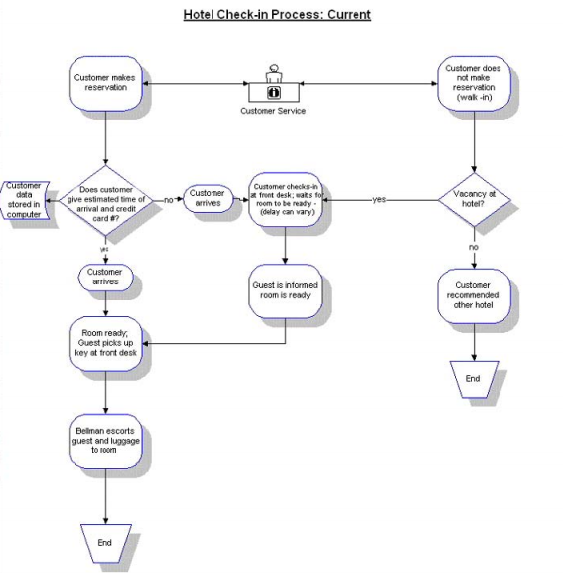
This is the schematic diagram of the current check-in process implemented at Escargo Hotel. It is a standard process used by many hotels between the 1990s – early 2000s, where the majority of modern hotel industry standards were developed (Taylor, 2018). It utilizes computer technology in order to store data. Most of the processes in this system are standardized with little variation regarding time. The only major variable, as illustrated by the chart, is the delay while the customer waits for the room. The average check-in time for Escargo Hotel is 4 minutes 51 seconds.
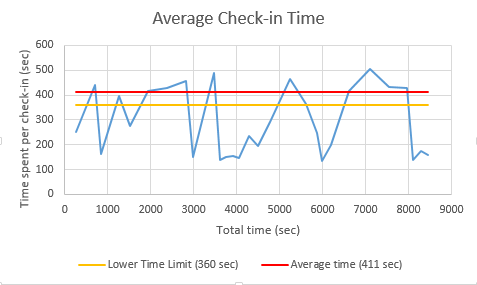
This control chart represents the average check-in times at Escargo Hotel and the lower time limit, which was taken from Touring Association Five Platinum Star Award (UNWTO, 2015). As it is possible to see, the check-in process varies from below to slightly above the lower time limit. Although in some scenarios a client may require more than the allocated 4 minutes in order to solve the issues they are having, the standard procedure must almost always fit within the allocated timeframe. Based on this line, it is concluded that there is room for improvement.
Checkout Process: Current

The checkout process follows the traditional checkout procedure utilized in most hotels (Taylor, 2018). Customers are given an opportunity to pay the bill via the on-command online service, which helps decrease the workload of the front deck. However, in the event of a system malfunction or in case the customer is not interested in paying online, they can check out and pay the bill at the front desk. Delay times vary based on the number of customers currently in the line-up.
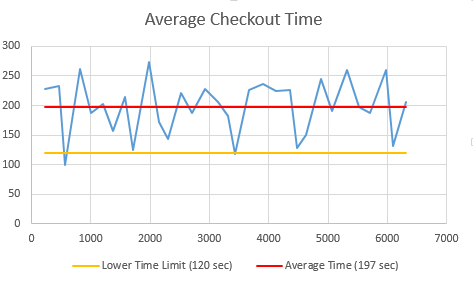
This control chart represents the average checkout times at Escargo Hotel and the lower time limit, which was taken from Touring Association Five Platinum Star Award (UNWTO, 2015). As it is possible to see, the check-in process is highly above the average time limit. In order to adhere to high standards of care, the average time must be reduced below the lower time limit. This could be achieved by streamlining and improving the existing process.
Analysis
Check-in and checkout processes are interconnected, as the front desk performs both operations. While the processes presented above cover all the phases in serving a single client, they may experience difficulties in handling large groups of people, such as groups of friends, crews, sports teams, or influxes of visitors during high-intensity periods. Increased workloads are associated with mistakes, confusion, and prolonged waits for customers, which is why the primary objective is to decrease the workload of every individual employee at the front desk and maximize the number of customers being served at the same time. This can be done in several ways.
One potential solution is to increase the number of front-end workers. If there are three receptionists instead of one, they would be able to handle larger crowds. However, employing more workers means paying more salaries and investing in personnel training. In addition, during low periods, three receptionists may be unnecessary. Seasonal employment would be more suitable.
Another measure would be to enable and facilitate self-service among customers. According to Kaushik, Agrawal, and Rahman (2015), self-service kiosks at hotels improve customer satisfaction, as they enable customers to perform alterations to their orders and check themselves out without having to wait in the line-up for the receptionist to attend to them. The cost of an average self-service kiosk varies between 3000-8000 USD, meaning that the price of installing four kiosks at the hotel reception hall would cost around 25000 USD with 500 USD of upkeep per month (“Your guide,” 2018).
At the same time, Escargo Hotel should enable online check-in and checkout that customers can access from their computers, smartphones, and tablets in order to be able to perform the required operations themselves. The price of creating a site varies between 5000 to 10000 USD with a 100-500 USD monthly upkeep (Wong, 2018).
Lastly, certain activities would need to be optimized in order to reduce waiting times. For example, in the event of a long line-up, should no rooms be available to the client, the receptionist is to dispense with calling another hotel in order to ask if they could provide a room for the guest. Simply suggesting another hotel and providing a phone number would save at least one minute of time.
Proposed Changes
Check-in Process: New
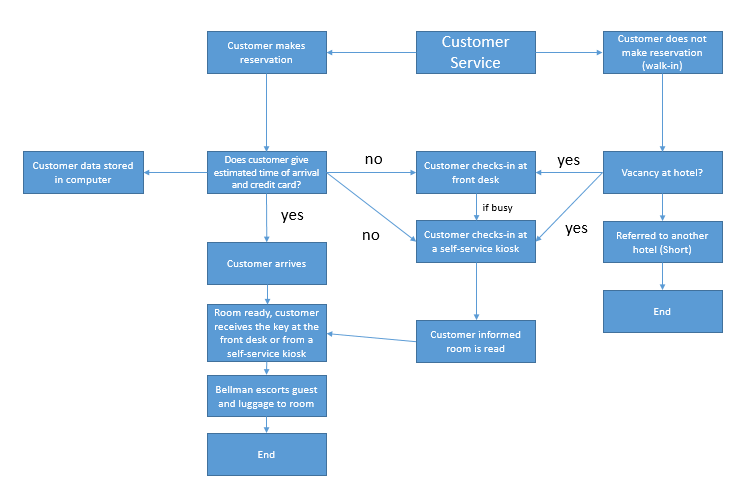
This new process scheme is an upgrade to the existing one in that it helps delegate some of the workload from the front desk by the installation of self-service kiosks. In addition, referrals to other hotels have been shortened by necessity in order to save extra time. In combination, these measures are expected to decrease the instances of check-in processes extending over 4 minutes to a minimum, as customers who do not want to wait in a line-up would be able to use self-service kiosks or online check-in services in order to speed up the process.
The new control chart presented below represents the estimates for average check-in times. As it is possible to see, reducing wait times by a minute during peak seasons significantly diminishes the overall average check-in time. As a result, customer satisfaction ought to increase, and delays will be lessened. Quality of service will remain just as high as before, as no important steps in ensuring quality and accuracy of the customer’s order have been skipped.
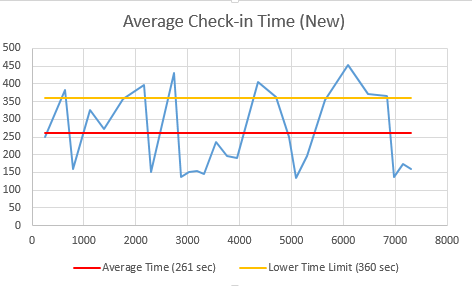
Checkout Process (New)
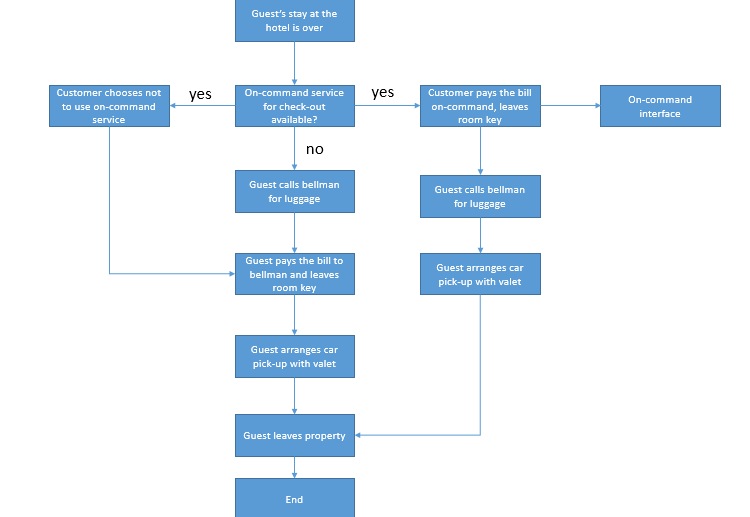
The proposed new schematic diagram for the checkout process is optimized in order to save time and reduce checkout inconveniences. The biggest inconvenience during the old process occurred at the reception desk – if it is busy with check-ins or other checkouts, the customer is forced to wait their turn in the line-up even though the operation is relatively quick, which involves paying the bill and retrieving the key. The new process takes the reception desk out of the equation, instead placing the duty upon the bellman, who is required to arrive for luggage anyway. In addition to saving time for customers, this change will reduce the workload of the reception desk, which would be dealing with check-ins alone.
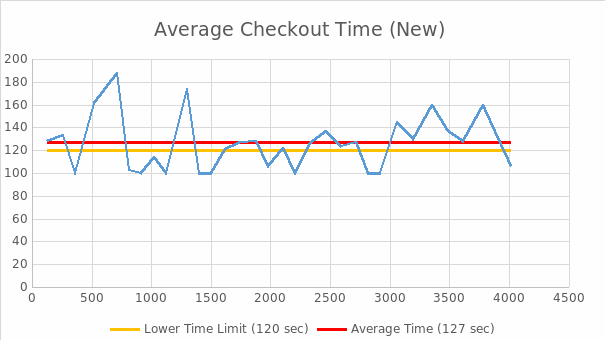
The control chart provided above represents the new estimated average check-out times for the proposed system. Evidently, taking the overworked reception desk out of the equation managed to save up to a minute of time, and make the average waiting time approach closer to the lower time limit set by the Touring Association Five Platinum Star Award (Taylor, 2018). Further decreases may be achieved through the training of staff, streamlining and simplifying the checkout operation process, or removing more steps from the schematic diagram. However, the latter is not recommended, as doing so would decrease the overall quality and affect customer satisfaction in a negative way.
DMAIC for Room Service
Six Sigma is a method devised for monitoring, controlling, and optimizing process performances. One of the most important and labor-intensive processes in the hotel industry is the room service process. Ensuring good service there is paramount. In order to be able to perform all these actions, a framework is required. One of the most frequently used frameworks within the scope of Six Sigma is the DMAIC, which stands for defining, measuring, analyzing, improving, and controlling the processes in question (Goetsch & Davis, 2016).
The issues that cause reduced efficiency of room services are presented in this fishbone diagram (Pearlman & Chacko, 2012):
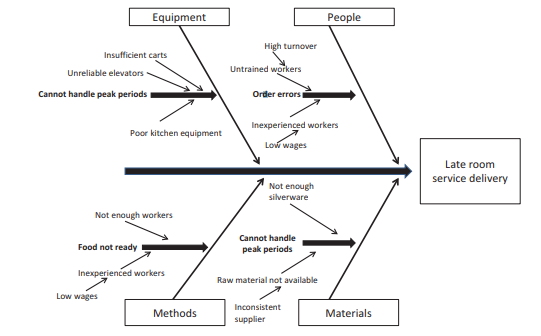
Interventions should be aimed at reducing the impact of the identified issues through training, optimization, and improvement. In order to be able to analyze the working processes, quantitative data must be obtained first. To gather information, managers and hotel employees will be required to utilize the E-tool – a web-based program that allows monitoring performance metrics as well as evaluate success and failure rates in each process (Schrijver, n.d.). Important variables include the speed of each operation, quality control, and customer feedback. In addition, workers would be required to submit self-reported data to discover any obstacles or inconsistencies in the existing processes.
Six Sigma offers numerous tools for data analysis. To be able to extract and disseminate information, the managers of Escargo Hotel could use the following items to guide their practices (Goetsch & Davis, 2016):
- Process maps. These are process schematics that show how actions are performed step-by-step;
- Cause-and-effect matrices. Help prioritize processes based on input and output variables;
- Failure mode and effect analyses. These are in-depth studies which analyze the effects of critical system failures;
- Control plans. Help analyze the effects of the implementation of Six Sigma projects;
- Paretto charts. These are bar charts and line graphs representing sources of defects.
The majority of issues with room service stem from low numbers of personnel, poor quality of training, and low wages that facilitate high turnover rates (Suboleski, 2012). Six Sigma interventions regarding room service must be aimed at reducing the negative effects of these factors. Investments must be made into personnel training and retention in order to improve room service.
Estimating the effects of the intervention can be done in numerous ways. The direct method will involve repeating the DMAIC process and comparing the results before and after the intervention. The indirect way of estimating the effectiveness of Six Sigma processes is to evaluate the income in a time period after the implementation of change. Since Six Sigma is aimed at the improvement and optimization of processes, overall outputs and income should see an increase. A lack of significant improvements indicates that the intervention had oversights.
Conclusion
Escargo Hotel would benefit from adopting the Six Sigma strategy as a core of its business. The strive for continuous improvement in quality, efficiency, accuracy, and process speed is going to increase customer satisfaction and attract new customers, while simultaneously saving money that would have otherwise been lost due to high turnover rates, inefficient processes, and mistakes. Six Sigma requires investments in training, supervision, and quality control processes. However, as evidenced by a mounting body of literature, these investments are almost always worthwhile.
References
Goetsch, D. L., & Davis, S. B. (2016). Quality management for organizational excellence: Introduction to total quality (8th ed.). New York, NY: Pearson.
Kaushik, A. K., Agrawal, A. K., & Rahman, Z. (2015). Tourist behaviour towards self-service hotel technology adoption: Trust and subjective norm as key antecedents. Tourism Management Perspectives, 16, 278-289.
Lu, C., Berchoux, C., Marek, M. W., & Chen, B. (2015). Service quality and customer satisfaction: Qualitative research implications for luxury hotels. International Journal of Culture, Tourism, and Hospitality Research, 9(2), 168-192.
Pearlman, D. M., & Chacko, H. E. (2012). The quest for quality improvement: Using Six Sigma at Starwood hotels and resorts. International Journal of Hospitality and Tourism Administration, 13(1), 48-66.
Schrijver, A. (n.d.). Web-based employee appraisal software. Web.
Suboleski, S. D. (2012). Room service principles and practices: An exploratory study. Web.
Taylor, A. (2018). Standard operating procedure for hotels. Web.
UNWTO. (2015). Hotel classification systems: Recurrence of criteria in 4 and 5 star hotels. Web.
Wong, C. (2018). How much should a website cost you? A definitive pricing guide for you. Web.
Your guide to installing self-serving kiosks. (2018). Web.